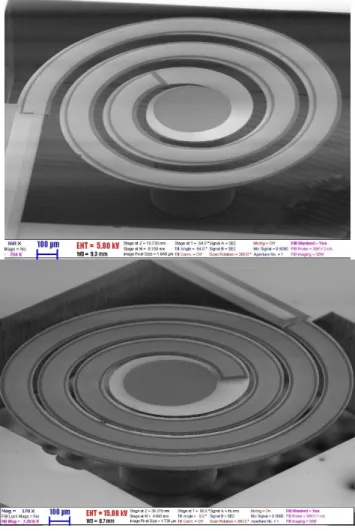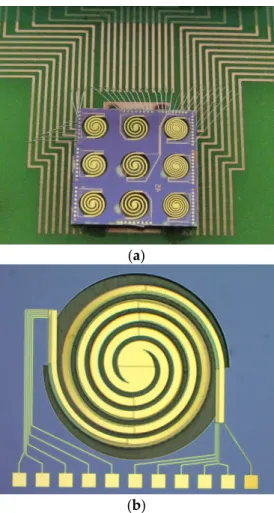Proceedings 2018, 2, 1059; doi:10.3390/proceedings2131059 www.mdpi.com/journal/proceedings
Proceedings
Low-Frequency Piezoelectric Accelerometer Array for Fully Implantable Cochlear Implants
János Radó 1,2,*, Péter Udvardi 1, Saeedeh Soleimani 1, Lucky Kenda Peter 1, István Bársony 1, Péter Révész 3 and János Volk 1
1 Institute of Technical Physics and Materials Science, Centre for Energy Research, HAS,
H-1121 Budapest, Hungary; udvardi.peter98@gmail.com (P.U.); soleimanisaeedeh@gmail.com (S.S.);
kendalucky1@gmail.com (L.K.P.); barsony.istvan@energia.mta.hu (I.B.); volk.janos@eenergia.mta.hu (J.V.)
2 Doctoral School on Materials Sciences and Technologies, Óbudai University, H-1034 Budapest, Hungary
3 Department of Otorhinolaryngology-Head and Neck Surgery, Clinical Center, University of Pécs, H-7601 Pécs, Hungary; revesz.peter@yahoo.com
* Correspondence: rado@mfa.kfki.hu; Tel.: +36-1-392-2222
† Presented at the Eurosensors 2018 Conference, Graz, Austria, 9–12 September 2018.
Published: 26 November 2018
Abstract: We demonstrate a low-volume, stress-free, piezoelectric micro-electromechanical system (MEMS) cantilever array for fully implantable hearing aids. The 12-element spiral-matrix is sensitive to the lower part of audible frequency range (300–700 Hz) through the proper resonant frequency of the individual spirals tuned by dimensions of the cantilevers. The obtained high Q-factors (117–
254) provide high frequency selectivity. The generated open circuit voltage signals could be sufficient for the direct analog conversion of the signals for cochlear multielectrode implants. By comparing different geometries we have also demonstrated that the initial stress, which is derived from silicon-dioxide (SiO2) and aluminum-nitride (AlN) layers, could be drastically reduced simply by the spiral geometry. The results of vibration measurements have shown a good agreement with the calculated resonant frequencies.
Keywords: cochlear implant; MEMS accelerometer; piezoelectric sensor; energy harvester; low- frequency device; Archimedean and Fermat spiral; aluminum-nitride (AlN)
1. Introduction
A fully implantable cochlear implant could offer several advantages for patients suffering severe hearing loss [1]. However, the miniaturization, complexity as well as self-powering, signal processing and cochlear multielectrode system are required from such a fully implantable device [2].
Correspondingly, these requirements are to be fulfilled in order to eliminate the use of external unit, i.e. microphone, sound processor, transmitter and battery, which are used in conventional semi- implantable hearing aids. In this work, instead of the direct detection of the sound (microphone), we demonstrate an accelerometer array, which could be mounted on one of the vibration transmitting bones, like anvil (incus), in the middle ear.
2. Materials and Methods
The demonstrated test device (Figure 1) was fabricated by standard bulk micromachining techniques [3]. Archimedean spiral geometry ensures the reduced device footprint formed by deep- reactive ion etching (DRIE). The uniformity of cantilever thickness is controlled by Si-on-Insulator (SOI) wafer. Aluminum nitride (AlN), as a biocompatible piezoelectric material, was deposited by reactive radio frequency (RF) sputtering from aluminum target. The accomplished sensor is mounted
Proceedings 2018, 2, 1059 2 of 3
on a printed circuit board (PCB) and then placed on a purpose designed 3D printed chip holder. The acceleration feedback signal is ensured by a miniaturized calibrated accelerometer.
Figure 1. Tilt-view scanning electron microscope (SEM) images of two typical cantilevers.
In the presented results (Table 1) sinusoidal excitation was applied at a feedback controlled acceleration of 1 g.
Table 1. Calculated and measured resonant frequencies, peak output voltages for each piezoelectric cantilever.
Chanel No. 1 2 3 4 5 6 7 8 9 10 11 12
Resonant frequency exp. (Hz) 281 45 365 374 389 408 417 425 497 526 663 672 Resonant frequency calc. (Hz) 283 337 366 348 377 379 424 473 471 543 679 687
Peak voltage (mV) 6.89 8.80 9.60 9.53 5.71 4.47 2.64 5.02 3.40 3.05 4.40 3.14 In addition, we have designed a test structure with different number of deposited layers for comparison by a 3D optical surface profiler and shown that the initial stress can be minimized by using spiral-shaped cantilever.
3. Results and Conclusions
In conclusion, the manufactured 2 mm × 2 mm cantilevers can satisfy the size constraint for middle ear implants and can provide a new generation of implantable hearing aids. Moreover, a multi-contact, Fermat-spiral-shaped cantilever array are under construction which may open the way to collect more than one ambient frequency with a single cantilever (Figure 2).
Proceedings 2018, 2, 1059 3 of 3
(a)
(b)
Figure 2. Wire bonded 9-element Fermat-spiral array (a) and a typical multi-contact, spiral-shaped cantilever (b).
Author Contributions: J.V., P.U., J.R., and J.V. carried out the Archimedean spiral design and performed the measurements. J.R., P.R. conceived and designed the Fermat spiral shape with the multi-electrode system. The fabrication of the devices was carried out by J.R., and S.S. J.R. built the testing setup, fabricated the chip holder for the shaker. L.K.P. assisted in the measurement. J.R., J.V., and I.B. wrote the paper and coordinated the work.
Acknowledgments: The work (KoFAH, NVKP_16-1-2016-0018) was supported by the National Research, Development and Innovation Fund of the Hungarian Government. János Radó is supported by the ÚNKP-17-3- I-OE-779/47 New National Excellence Program of the Ministry of Human Capacities. József Pytel and B&K engineer, Péter Szuhay are acknowledged for the fruitful discussions. The authors thank the contribution of Margit Payer for sample fabrication and Attila Nagy for wire bonding and chip packaging.
Conflicts of Interest: The authors declare no conflict of interest. The founding sponsors had no role in the design of the study; in the collection, analyses, or interpretation of data; in the writing of the manuscript, and in the decision to publish the results.
References
1. Wilson, B.S.; Dorman, M.F. Cochlear implants: current designs and future possibilities. J. Rehabil. Res. Dev.
2008, 45, 695–730.
2. Cohen, N. The Totally Implantable Cochlear Implant. Ear Hear. 2007, 28, doi:10.1097/AUD.0b013e31803150f4.
3. Udvardi, P.; Radó, J.; Straszner, A.; Ferencz, J.; Hajnal, Z.; Soleimani, S.; Schneider, M.; Schmidt, U.; Révész, P.; Volk, J. Spiral-shaped piezoelectric MEMS Cantilever array for fully implantable hearing system.
Micromachines 2017, doi:10.3390/mi8100311.
© 2018 by the authors. Licensee MDPI, Basel, Switzerland. This article is an open access article distributed under the terms and conditions of the Creative Commons Attribution (CC BY) license (http://creativecommons.org/licenses/by/4.0/).

